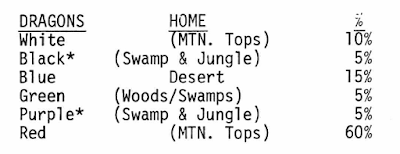Unlike many other forms of advance warnings about upcoming events, the infamous Gypsy Sayings merely state what might happen, and allow the players a chance to get out of the steamroller's way. Gypsy Sayings are also obscure, generally, and subject to numerous interpretations about their meaning. One man's cake is another man's poison....
Dave Arneson, The First Fantasy Campaign
Gypsies, or the
Romani people, have traditionally been associated with fortune-telling, something which was also incorporated as a plot mechanic in I6 "Ravenloft" (1983), although concerns were rightly raised about the portrayal of the Vistani in 5E's
Curse of Strahd.
Gypsy fortuneteller, illustration by Val Mayerick, from A Guide to Transylvania (1996) by Nicky Rea
After a two day stand at the edge of town, where almost the entire town partook of the entertainment offered. There were several private performances by individual female members of the troop up at the castle along with a rash of fortune telling. Shortly after the completion of the last performance the band disappeared during the great Earthquake of All Hallows Eve last.
Arneson states that "Gypsy Sayings" were first used in the 2nd year of the original Blackmoor Campaign. He provides these in JG 37 "
The First Fantasy Campaign", along with explanations in parentheses:
1) When the six Vultures alight on the six hills, Doom will come in six turns.
(The Vultures are a giant variety that live above Wolf's Head Pass. There were only four hills on the playing board, but the player's forgot about two towers in the area. Doom, referred to Wizard's Darkness and should have read "Gloom".)
2) Those who live in Darkness desire Light.
3) When three rule the land, the Dark Lord will come.
(Referring to the committee set up by three of the players to rule Blackmoor. Such a political mishmash would certainly cause the Baddies to attack thinking that the opposition was too divided to resist.)
4) When the skies Darken at noon, the land will be barren.
(Bad weather)
5) That which is valuable is well-guarded.
6) When Evil gathers its Might, two will succeed where a Host fails.
(Rather than get the Army wiped out, try an assassination!)
7) The Jewel of the Sun will pierce any Darkness.
(Reference to an artifact.)
8) When the Undead walk, their companion is Darkness.
(Undead shun darkness, so ...)
9) A man who is an animal is not man.
(An interesting psychological discussion on Lycanthropy or maybe personal habits....)
10) Light will conquer Dark but a Cloud can be a Shield.
11) The Evil that lurks in man is always present.
(Paranoia anyone??)
12) The Mists at noon foretell far-reaching Doom.
(If there is fog everywhere, then the Baddies are probably sneaking up on the walls. Or perhaps Doom just means Gloom. Gypsy accents are terrible.)
13) That which is, might not be.
(Psychological talk or comment on Phantasmal Forces??)
14) Rider, Jewel and Marsh are a Doomful Threesome.
(see Temple of the ID.)
Arneson finishes by stating these "should be used sparingly and changed regularly" and "are especially useful if a particular scenario is planned, like saving a Princess, or saving someone's hide...." by which I'm not sure what he means.
Legends
The "Gypsy Sayings" section is followed by "Legends". Arneson describes these as a refinement of the "Gypsy Sayings" and indicates there were 100 of them, but that 75 were false.
False legends were randomly determined to be local (presumably in the vicinity of Blackmoor; 1-2), arising from Vestfold (3-5), or beyond (6). Additional determination is made for "Gold PD x PD x 1000" (1-4), "Philosopher's Stone" (5), or "Magic" (6).
I'm not sure what "Gold PD x PD x 1000" means. Perhaps the false legend could refer to a cache of gold, a mythical "Philosopher's Stone", or some type of magic item?
There are 25 True legends ("sort of"). These appear to represent a list of magic items or artifacts (with a location given for some of them):
1) The Mare of Steel
2) Sign of the Wolf (Blackmoor Dungeon)
3) The Prisoners Stone
4) The Black Egg of Blackmoor (Pete's Place)*
*likely in reference to Pete Gaylord "The Wizard of the Wood"
5) Place of the Gods
6) The Frogs (Rocky)* (Temple of the Frog)
*likely in reference to Stephen Rochford "Saint Stephen the Rock"
7) Orc Treasure (Freddy)* (Blackmoor)
*likely in reference to Fred Funk "King of the Orcs"
8) Emperor's Crown
9) Dragon's Island (Blackmoor Dungeon)
10) Radiator of Death (Dray Is. Blk. M.)
11) Loch Gloomen Legend (L.G. #F)*
*Castle (13 Rooms, 4 Passages, 2 Levels) 370 Magic Points (25 Ogres) Shape Changing, Fireball Wand, Fighting Machine
12) Loch Gloomen Legend (L.G. #E)*
*House (10 Rooms) 310 Magic Points (twelve Wrights), Sword (lettered), Horse (4), Water Machine
13) The Great Bell (4000 #) 2 1/2 mil.
14) Viking Cap. 1 #
15) Viking Cap. 2 #
16) Egg of Coot (Egg of Coot)
17) Throne of the Skies
18) Throne of the Gods
19) "The Golden Dragon"
20) Sign of the Eagle
21) Sign of the Elephant
22) Treasure of the Payme Princess
23) Three Crowns of Tonisberg (Tonisberg)*
24) Mount Rocky* (Duchy of Ten)
*mentioned as a dragon breeding area in the Ran of Ah Fooh's description
25) Mount Doom (Egg of Coot)
Not much else is known about the "Legends" section, which has been the topic of a couple of threads in the past, over at
The Comeback Inn.


































